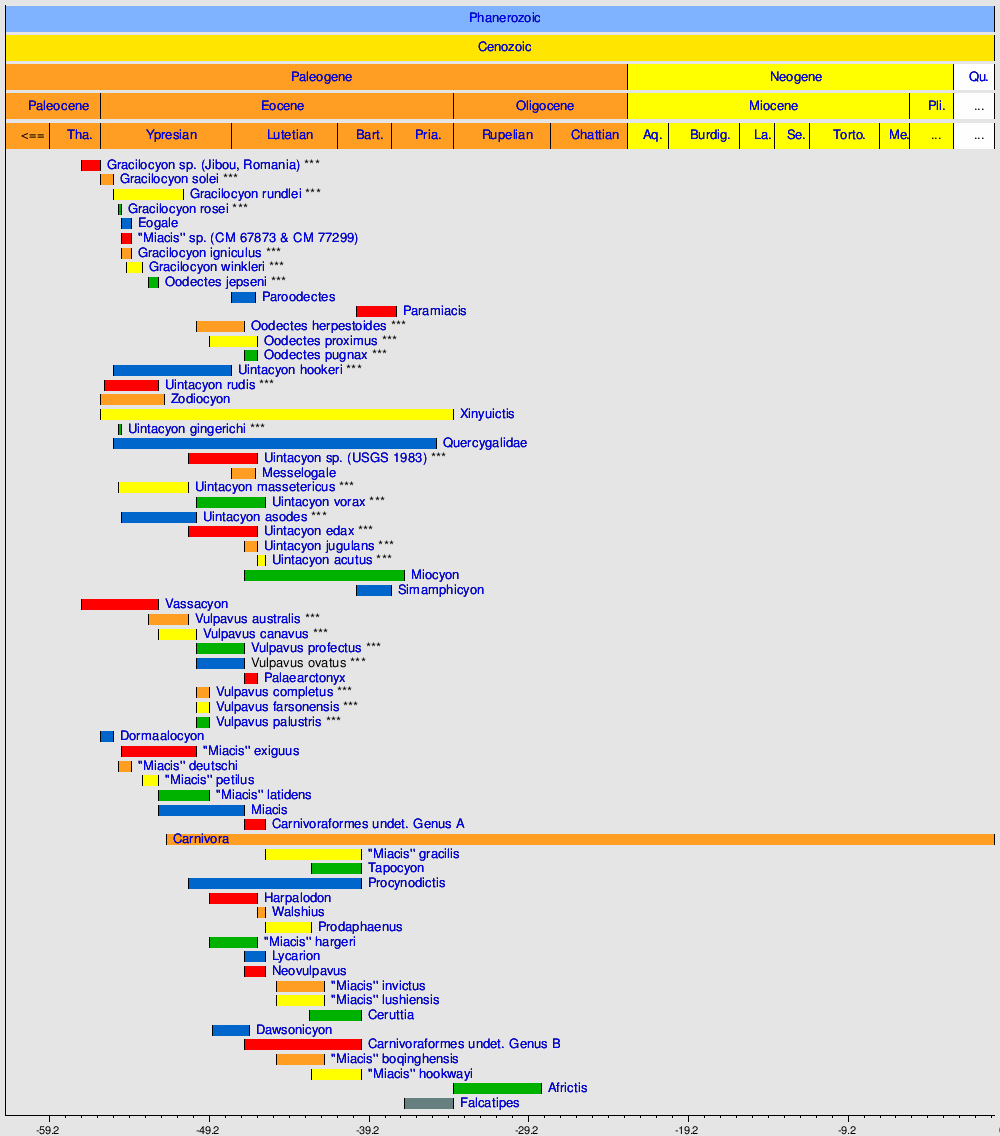Phlaodectes
izumrli podrod placentalni sisara
Phlaodectes (Флаодектес — „онај који гризе и дробити зубима”) је изумрли подрод плацентални сисара из изумрлог парафилетског рода Vulpavus, који је у периоду од раног до средњег Еоцена настањивао подручје Сјеверне Америке.[1]
| Phlaodectes Временски распон: рани до средњи Еоцен
| |
|---|---|

| |
| костур врсте Vulpavus ovatus | |

| |
| реконструкција изгледа врсте Vulpavus ovatus | |
| Научна класификација | |
| Домен: | Eukaryota |
| Царство: | Animalia |
| Тип: | Chordata |
| Класа: | Mammalia |
| Кладус: | Pan-Carnivora |
| Кладус: | Carnivoramorpha |
| Кладус: | Carnivoraformes |
| Род: | †Vulpavus |
| Подрод: | †Phlaodectes Matthew, 1909 |
| Типска врста | |
| †Vulpavus ovatus Matthew, 1909
| |
| Врсте | |
| |
| Синоними | |
|
синоними врсте:
| |
Етимологија назива
уреди| Подрод: | Поријекло назива од: | Значење назива: |
|---|---|---|
| Phlaodectes | онај који гризе и дробити зубима |
| Врсте: | Поријекло назива од: | Значење назива: |
|---|---|---|
| V. ovatus | јајолики Вулпавус |
Систематика
уредиКласификација
уреди| Врсте: | Распрострањеност фосила и локација: |
Временски распон: |
|---|---|---|
| †V. ovatus (Matthew, 1909)[2] | САД (Вајоминг) | 50,5 до 46,2 мил. год. |
Филогенија
уредиДоље приказан кладограм представља филогенетске везе подрода Phlaodectes.[3][4][5][6]
| Carnivoramorpha |
|
†Gracilocyon/Oodectes група †Vulpavus група | ||||||||||||||||||||||||||||||||||||||||||||||||||||||||||||||||||||||||||||||||||||||||||||||||||||||||||||||||||||||||||||||||||||||||||||||||||||||||||||||||||||||||||||||||||||||||||||||||||||||||||||||||||||||||||||||||||||||||||||||||||||||||||||||||||||||||||||||||||||||||||||||||||||||||||||||
| (Carnivora [sensu lato]) | ||||||||||||||||||||||||||||||||||||||||||||||||||||||||||||||||||||||||||||||||||||||||||||||||||||||||||||||||||||||||||||||||||||||||||||||||||||||||||||||||||||||||||||||||||||||||||||||||||||||||||||||||||||||||||||||||||||||||||||||||||||||||||||||||||||||||||||||||||||||||||||||||||||||||||||||||
Временска распрострањеност подрода Phlaodectes унутар кладуса Carnivoraformes
уреди
Види још
уредиРеференце
уреди- ^ McKenna, Malcolm C.; Bell, Susan K. (1997). Classification of Mammals Above the Species Level. New York: Columbia University Press. ISBN 978-0-231-11012-9. Приступљено 16. 3. 2015.
- ^ W. D. Matthew (1909.) "The Carnivora and Insectivora of the Bridger Basin, middle Eocene." Memoirs of the American Museum of Natural History 9:289-567
- ^ Flynn, John J.; Finarelli, John A.; Spaulding, Michelle (2010). „Phylogeny of the Carnivora and Carnivoramorpha, and the use of the fossil record to enhance understanding of evolutionary transformations”. Ур.: Goswami, Anjali; Friscia, Anthony. Carnivoran evolution. New views on phylogeny, form and function. Cambridge University Press. стр. 25–63. ISBN 9781139193436. doi:10.1017/CBO9781139193436.003.
- ^ Solé, Floréal; Smith, Richard; Coillot, Tiphaine; de Bast, Eric; Smith, Thierry (2014). „Dental and tarsal anatomy of Miacis latouri and a phylogenetic analysis of the earliest carnivoraforms (Mammalia, Carnivoramorpha)”. Journal of Vertebrate Paleontology. 34 (1): 1—21. ISSN 0272-4634. doi:10.1080/02724634.2013.793195.
- ^ Solé, Floréal; Smith, Thierry; De Bast, Eric; Codrea, Vlad; Gheerbrant, Emmanuel (2016). „New carnivoraforms from the latest Paleocene of Europe and their bearing on the origin and radiation of Carnivoraformes (Carnivoramorpha, Mammalia)”. Journal of Vertebrate Paleontology. 36 (2): e1082480. ISSN 0272-4634. doi:10.1080/02724634.2016.1082480.
- ^ Tomiya, S.; Zack, S. P.; Spaulding, M.; Flynn, J. J. (2021). „Carnivorous mammals from the middle Eocene Washakie Formation, Wyoming, USA, and their diversity trajectory in a post-warming world”. Journal of Paleontology. 95 (Supplement S82): 1—115. doi:10.1017/jpa.2020.74.